Why the "Perambulating Library," otherwise known as The Bookmobile, continues to stick around
Why we still want, and need, books on wheels.
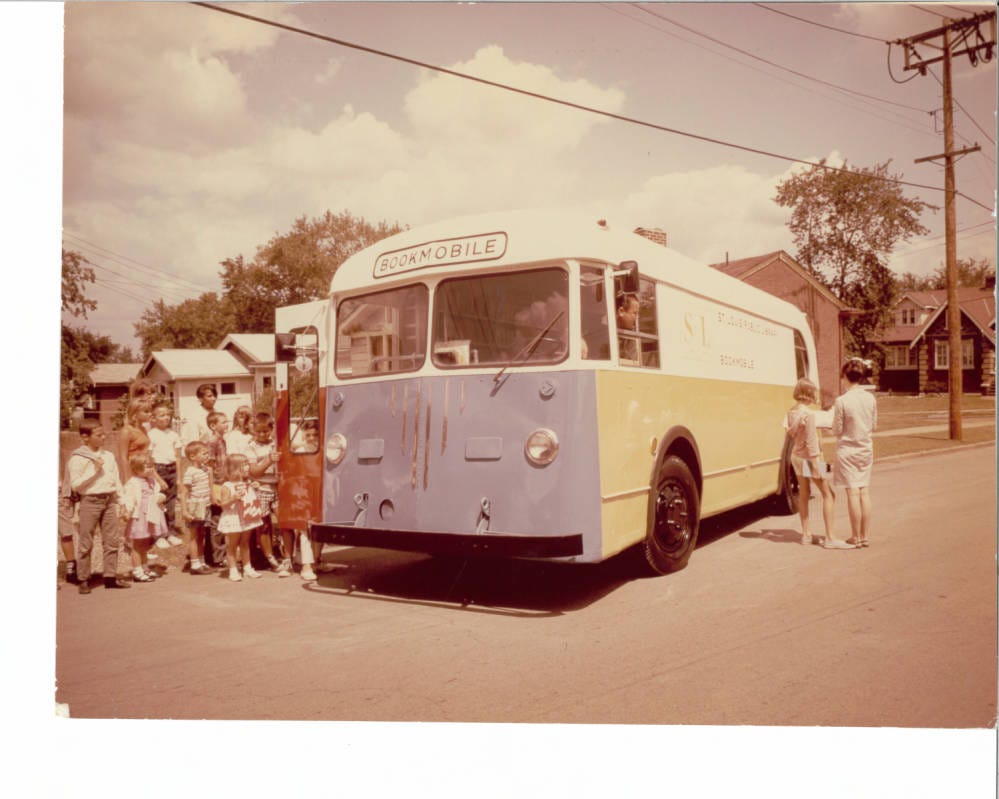
In 1970, the Sioux Falls Public Library retired “Old Chugger,” its first bookmobile. A souped-up 1951 Dodge, the library earmarked $9,000 in library fines and paid the Gerstenslager Company of Wooster, Ohio — the company behind the Oscar Mayer Weinermobile — to build it out.
Pauline Streiner, Old Chugger’s first librarian, drove it five days a week for 19 years, making two stops a day: in public parks, at the airbase school, on specific streetcorners, next to school playgrounds. A generator heated and cooled the interior. The shelves were slanted so the books stayed put, and were lit so you could browse for books on dark winter afternoons. When it came time to drive Old Chugger into the city garage for the last time, Steimer handed the keys to her fellow librarian, Shirley Wilson, who usually drove “Bookmobile No. 2,” which followed Chugger into service in 1957. (The fact that librarians drove the buses themselves, rather than hiring drivers, was a point of pride.)
As the Times-Argus noted, the library replaced Old Chugger with “a gleaming modern version of the horse-drawn book van that rumbled thorugh the pages of Christopher Morley’s Parnassus on Wheels.” It didn’t have a charming name, or any name at all, but was seven feet longer and held 3,100 books, 600 more than the older bookmobiles. And it had actual heating and air-conditioning.
Even though most library cards give people access to all the e-books, audiobooks, movies and video games they can take, people still want to go inside physical libraries, including Bookmobiles. Maybe the novelty of books on wheels will never wear off.
The historical precursor to the bookmobile, the The Perambulating Library, was invented in Cheshire, England in 1859. Called “one of the most revolutionary library advances of the 19th century,” it was a one-horse wagon, built by the Warrington Mechanics Institute, and paid for by Cheshire residents themselves, who raised the money with a flower show.
By the late 19th century, book wagons were everywhere, and people not only borrowed the Mechanic Institute’s design, but the name as well. A 1920 article in the Lima News described a “perambulationg library” making the rounds of small Ohio towns for the benefit of those who were “scantily supplied with good reading matter.” It was outfitted with a pop-up book display “so that quite a considerable collection may thus be set out.”
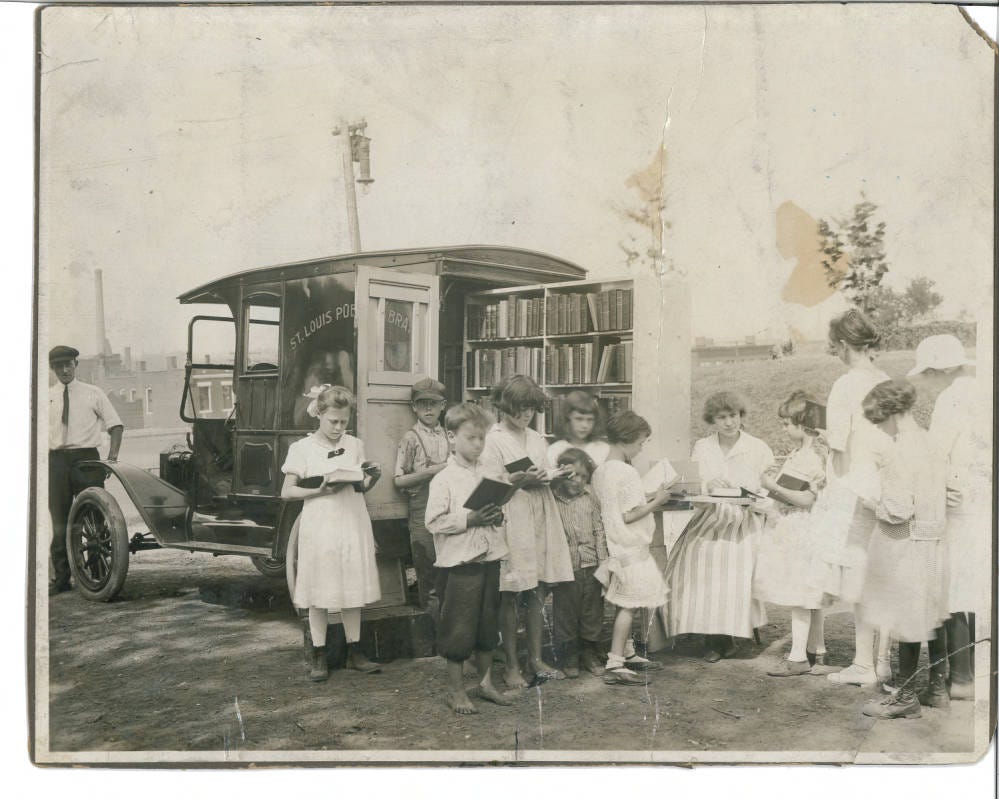
St. Louis was decades ahead of other cities when it came to mobile library services. In the 1910s, it sent out wagons full of lantern slides to the public schools as teaching aids; that program evolved into one of the most sophisticated, before-its-time A/V library collections in the country. It was an early adopter of bookmobiles, sending out a “Book Truck,” as early as 1919.
Its first big, official modern bookmobile, the Hanford-Crawford, was named for the philanthropist who donated the money to build it. Here’s a piece in the St. Louis Post-Dispatch, announcing its launch in December of 1940. As noted in the piece — a very curious piece of history here — prior to establishing a fleet of bookmobiles, libraries often distributed books via neighborhood drugstores:
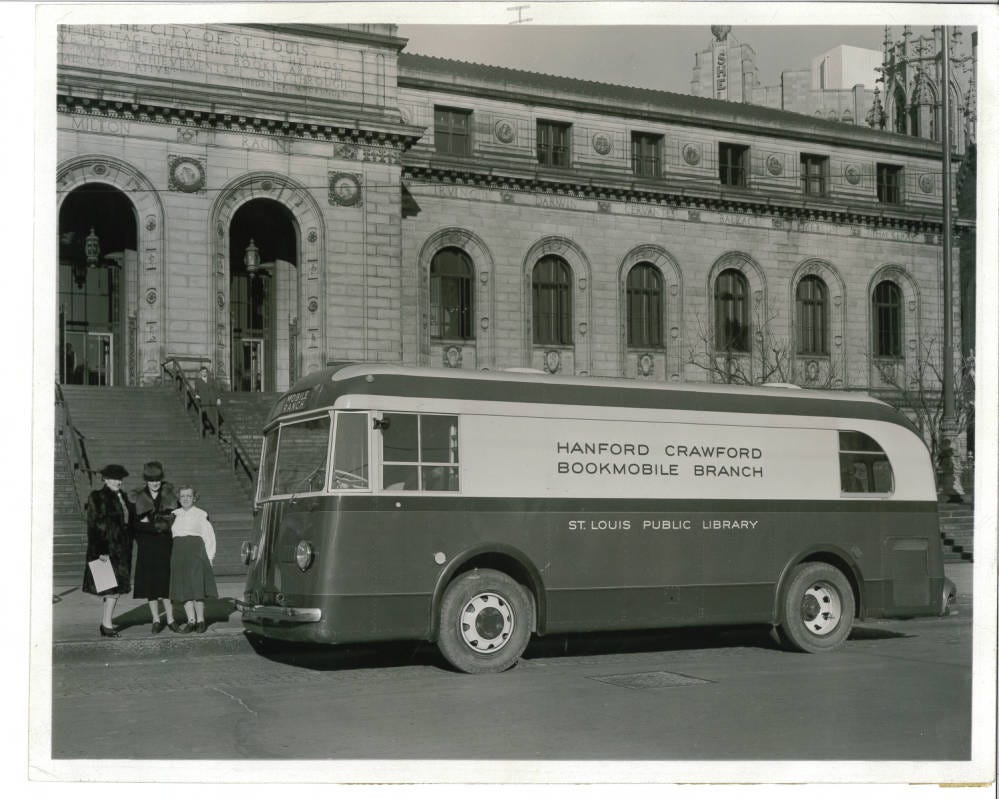
Later on, the SLPL’s bookmobiles had much cooler names, including The Pegasus and The Pied Piper. When The Pegasus rolled out in 1955, it was substantially bigger than SLPL’s other three bookmobiles. As the St. Louis Argus noted, it was also built by Gorstenlager of Weinermobile fame; the company installed 245 feet of shelving and outfitted the interior with natural pine and state-of-the art florescent lights. Pegasus held 3,000 books, a third for kids and a fourth for adults.
By 1955, the St. Louis County Library had its own separate fleet of bookmobiles, which it launched in Florissant in 1947 — North County was still considered rural at that point, and part of the project, like with many bookmobiles, was getting books to far-strewn communities that were too small to establish a library.
The St. Louis County Library now operates four bookmobiles, with two more coming next year. The St. Louis Public Library, as far as I can tell, has none. But considering what’s happening in red states right now, maybe that’ll change.
In response to book bans in Florida and Texas, libraries and bookstores are rolling out guerilla book buses. Sarasota’s Shelf Indulgence bookstore bought a used Bluebird schoolbus and is currently crowdfunding to convert it into a Banned Books Bus. Similar projects are popping up in Texas, and MoveOn toured a roaming Banned Bookmobile this summer. (Here’s the current scope of book bans, courtesy of Pen America.)
“Today’s rebel bookmobiles serve a vital role by bringing the perspectives and experiences of other, different lives, pushing against efforts to deny their existence,” H.L.M. Lee wrote in an Op/Ed for WBUR. “Books by Black authors, about Black history and slavery; books with issues concerning LGBTQ+ characters, Jewish characters, Asian characters; books about Indigenous peoples; books that portray the painful history of minorities in our country — these and many more have all recently been banned as objectionable to someone for some reason, often for the sin of causing discomfort to students.”
To end on a less heavy note, here’s a vintage short that makes a pitch for why libraries matter, including some footage of some sleek ol’ Midcentury bookmobiles on the road, starting at about the 11:00 mark.
By the way: hallo and thanks, new subscribers! That would be Jacob V and Piyush S. I appreciate you. As always, if have suggestions or ideas about history topics, feel free to kick ‘em this way. Cheers to the weekend!


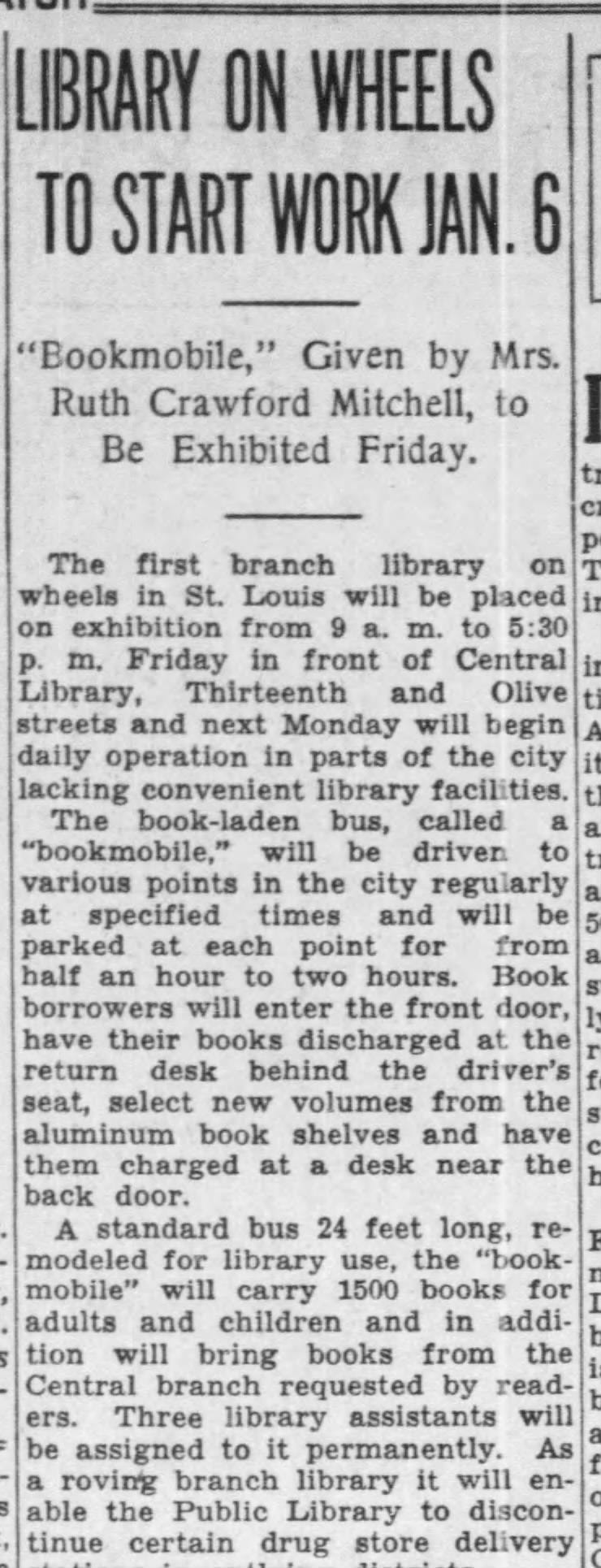
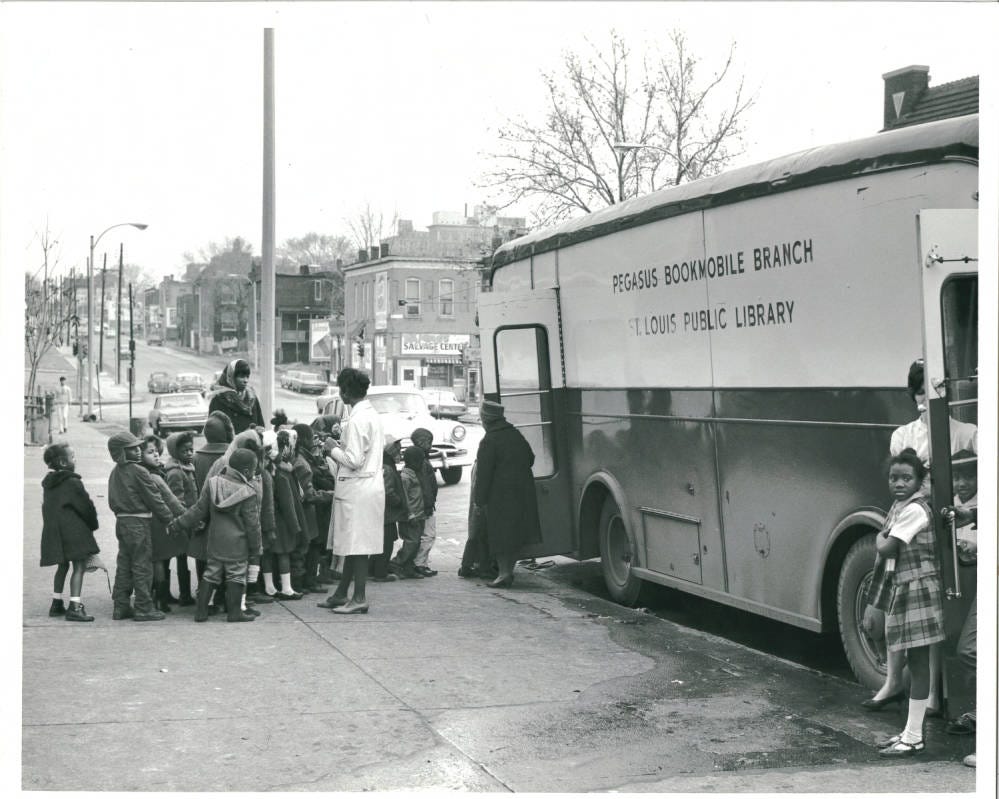
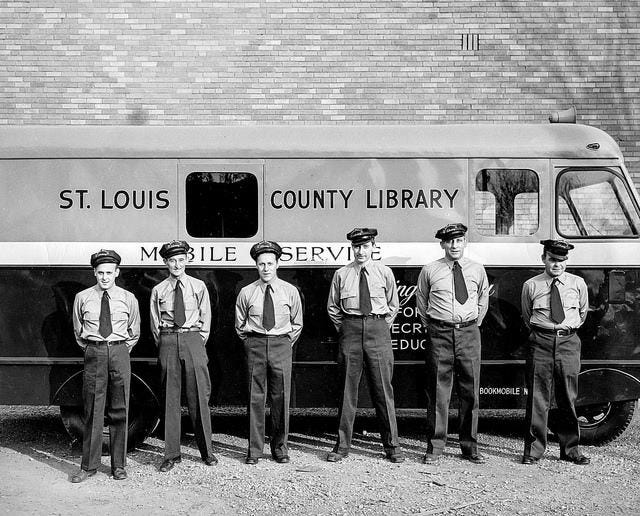
This triggered fond memories of the school book fair. In third grade I picked out Never Eat Anything Bigger Than Your Head by B. Kliban. Kliban was enjoying a moment of great commercial success thanks to his more mainstream Cat cartoons, so whoever was selecting the books must have just grabbed a stack of his work without putting any thought into it. Later that day one of my teachers caught me having a giggle with my pals over the "Man Wearing Ear Muffs" cartoon (you'll have to look it up), and suggested gently, but persuasively, that I might want to exchange it for a different title. I agreed, but repurchased the book later on my own time with my own dime. I learned two important lessons from this episode at a very early age; 1.) The power of absurdist humor and 2.) The distrust of authority figures.
Ah, the Bookmobile. I remember checking out Oeanuts “Happiness is a Warm Puppy” and “Where the Wild Things Are” as a kid and all of the Alfred Hitchcock mystery series a bit after that. I ensured I’d return them in good condition with a stamp of my library card. A small piece of Manila card stock with a metal dog tag embedded into it. That card was my prize possession. Thanks always for these trips down memory lane. ❤️